We are pleased to announce the 2023 Association for Mormon Letters Awards finalists in creative nonfiction, religious nonfiction, and criticism. The final awards will be announced and presented on July 20, as part of the 2024 Association for Mormon Letters Virtual Conference. We will be announcing the other category finalists over the coming week. The finalists and winners are chosen by juries of authors, academics, and critics. The announcements include blurbs and author biographies, usually adapted from the creator and distributor websites.
Creative Nonfiction
Joshua Foster. The Clean Package: A Pioneer Assemblage.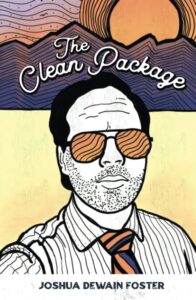
The Clean Package: A Pioneer Assemblage is an award-winning hybrid essay and short story collection anthologizing fifteen years of Foster’s exploration and experimentation as a Millennial writer and storyteller. Blurring boundaries of fiction and nonfiction, narratives roam from his inherited Mormon roots in Idaho and Utah to strange and new landscapes in Alabama, Arizona, California, Texas, New York City, where Foster reports on and fictionalizes his postmodern Pioneer life in the ever-evolving American West.
Melissa Wei-Tsing Inouye and Kate Holbrook, eds. Every Needful Thing: Essays on the Life of the Mind and Heart. Maxwell Institute.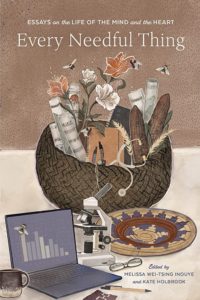
A collection of essays from accomplished academics and professionals who speak about discipleship not only with their minds but also from their hearts. Instead of pushing us to choose between faith and reason, love and law, truth within the restored gospel and truth in the wider world of God’s children, these writers urge us to seek “anything virtuous, lovely, or of good report” and learn to live in a world of complexity and abundance. With humility and openness that makes their specialized work accessible to a general reader, these authors model how to live life as a whole person. They relate the twists and turns of their intellectual and spiritual journeys, giving readers confidence to make their own ways and to pursue “every needful thing” (D&C 88:119).
D. Michael Quinn. Chosen Path: A Memoir. Signature.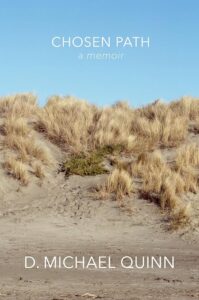
After D. Michael Quinn’s death in April 2021, his children found his remarkable, unpublished memoir in his home and entrusted Signature Books with its publication. Relying on his journals, primary research, and reminiscences, Quinn shares his life story as few have heard it–from his father’s hiding of his true name and Mexican identity, to his upbringing by his abusive grandmother, to his choice to closet his homosexuality, to his undying commitment to his faith and its history. Throughout his telling, Quinn unflinchingly opens up about his feelings and experiences that shaped his enigmatic life.
Religious Nonfiction
Grant Hardy. The Annotated Book of Mormon. Oxford University Press.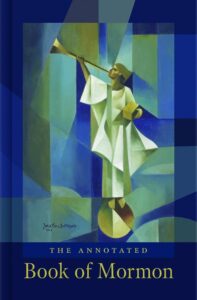
The first fully annotated, academic edition of the Book of Mormon reformats the full scriptural text in the manner of modern Bible translations and contains extensive annotations provide the meaning of specific phrases, the significance of particular episodes, intricacies of the narrative, rhetorical patterns, theological implications, and connections with the Bible. It also includes book introductions and general essays that overview large sections of the text and quickly summarize ongoing debates about the book, respectively.
Eric D. Huntsman and Trevan G. Hatch. Greater Love Hath No Man: A Latter-day Saint Guide to Celebrating the Easter Season. BYU Religious Studies Center.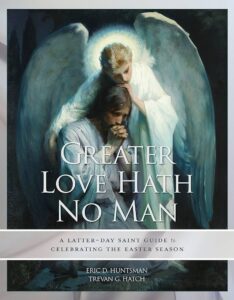
This volume organizes the chapters according to the traditional days of Holy Week with expanded discussion and additional materials. After discussing the scriptural accounts for each day of Holy Week, the chapters then summarize how these scriptural events have been celebrated through the centuries in different Christian traditions before sharing suggestions on how Latter-day Saints can both study the texts and commemorate the events in their own families.
Benjamin Keogh, Joseph M. Spencer, Jennifer Champoux, eds. Approaching the Tree: Interpreting 1 Nephi 8. Maxwell Institute.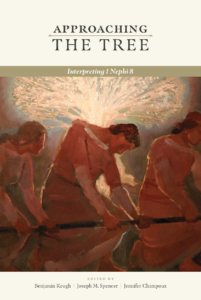
Approaching the Tree is an invitation to view again one of the Book of Mormon’s best-known texts. From the fresh interactions of an array artists and scholars, the theological significance of Lehi’s dream emerges anew. Together these able guides show, once more, both book and dream to be rich and deep, worthy of repeated reflection.
Joseph M. Spencer. A Word in Season: Isaiah’s Reception in the Book of Mormon. University of Illinois Press.
The Book of Mormon’s narrative privileges Isaiah over other sources, provocatively interpreting and at times inventively reworking the biblical text. Joseph M. Spencer sees within the Book of Mormon a programmatic investigation regarding the meaning and relevance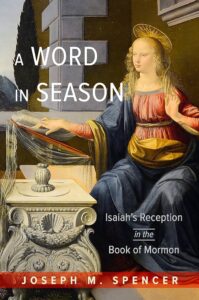 of the Book of Isaiah in a world increasingly removed from the context of the times that produced it. Working from the crossroads of reception studies and Mormon studies, Spencer investigates and clarifies the Book of Mormon’s questions about the vitality of Isaiah’s prophetic project. Spencer’s analysis focuses on the Book of Mormon’s three interactions with the prophet: the character of Abinadi; the resurrected Jesus Christ; and the nation-founding figure of Nephi. Working from the Book of Mormon as it was dictated, Spencer details its vital and overlooked place in Isaiah’s reception while recognizing the interpretation of Isaiah as an organizing force behind the Book of Mormon.
of the Book of Isaiah in a world increasingly removed from the context of the times that produced it. Working from the crossroads of reception studies and Mormon studies, Spencer investigates and clarifies the Book of Mormon’s questions about the vitality of Isaiah’s prophetic project. Spencer’s analysis focuses on the Book of Mormon’s three interactions with the prophet: the character of Abinadi; the resurrected Jesus Christ; and the nation-founding figure of Nephi. Working from the Book of Mormon as it was dictated, Spencer details its vital and overlooked place in Isaiah’s reception while recognizing the interpretation of Isaiah as an organizing force behind the Book of Mormon.
Taylor G Petrey, Cory Crawford, Eric A. Eliason, eds. The Bible and the Latter-day Saint Tradition. University of Utah Press.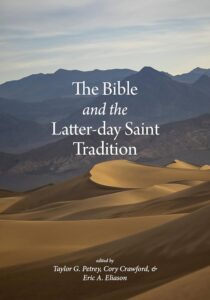
Like other Christian denominations, the Church of Jesus Christ of Latter-day Saints (Mormons) has been engaged in the battle for the Bible since challenges to biblical authority began to exert significant influence in America toward the end of the nineteenth century. Latter-day Saints have experimented with similar approaches, often taking liberal positions on biblical authority and conservative positions on history and authorship. However, Latter-day Saints accept additional scripture and embrace a theology notably distinct from traditional Christianity. Hence, they relate to the Bible differently from other Christians, creating gaps with mainstream biblical studies. This volume bridges that gap. From comparing the Book of Mormon to the Bible or the Dead Sea Scrolls, to Mormon feminists’ views on the Gospels, this volume takes a comprehensive and inclusive approach to understanding Bible scholarship’s role in Mormon history, exploring these differences for both scholars and students. A diverse group of contributors presents an accessible resource to mediate between Latter-day Saint traditions and the broader context of biblical history, literature, and scholarship.
Special Award in Religious Nonfiction
Fatimah Salleh and Margaret Olsen Hemming. The Book of Mormon for the Least of These, volumes 1-3. BCC Press.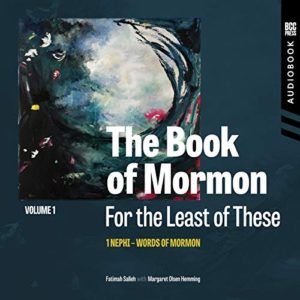
These social justice commentaries of the Book of Mormon empowers readers to understand the text as a book that speaks to issues of racism, sexism, immigration, refugees, and socioeconomic inequality. The Book of Mormon For the Least of These offers an unflinching examination of some of the difficult and troubling sections of the Book of Mormon, while also advocating for a compassionate reading of holy text. As a verse-by-verse close reading, this book examines new layers of interpretation and meaning, giving even those deeply familiar with scripture innovative tools for engaging powerfully with the Book of Mormon.
Criticism
Mason Kamana Allred. Seeing Things: Technologies of Vision and the Making of Mormonism. University of North Carolina Press.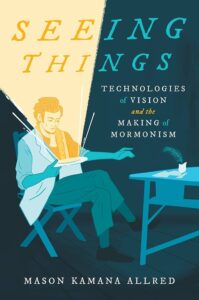
In this theoretically rich work, Mason Kamana Allred unearths the ways Mormons have employed a wide range of technologies to translate events, beliefs, anxieties, and hopes into reproducible experiences that contribute to the growth of their religious systems of meaning. Drawing on methods from cultural history, media studies, and religious studies, Allred focuses specifically on technologies of vision that have shaped Mormonism as a culture of seeing. These technologies, he argues, were as essential to the making of Mormonism as the humans who received, interpreted, and practiced their faith. Allred’s analysis reveals Mormonism as always materially mediated and argues that religious history is likewise inherently entangled with media.
Michael Austin and Rachel Meibos Helps. “‘The Gospel of Intelligence and Culture’: Literature and Literary Instruction in the Twentieth-Century MIA Curriculum.” BYU Studies, 62:2.
“The opening decades of the twentieth century produced an unprecedented outpouring of literary instruction and reading encouragement from the youth auxiliaries of the Church.”
Stephen Carter. Virginia Sorensen: Pioneering Mormon Author. Signature.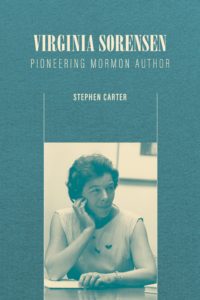
In the 1940s she was a New York Times bestselling author—of Mormon novels. In the 1950s she won a Newbery Medal, the highest honor in children’s literature. But today, hardly anyone knows her name. Who is Virginia Sorensen? How did a girl who grew up in a tiny Utah town in the 1920s become a globetrotting, award-winning author? And why has she been forgotten? Though she wrote them four generations ago, Sorensen’s novels are more urgent today than ever, addressing issues both Mormons and former Mormons grapple with. Her body of work is a treasure trove of insight, compassion, and storytelling waiting to be rediscovered.
Gavin Feller. Eternity in the Ether: A Mormon Media History. University of Illinois Press.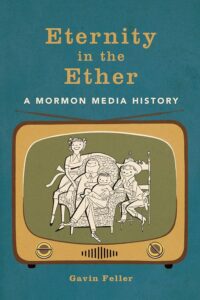
Mass media and the Church of Jesus Christ of Latter-day Saints evolved alongside each other, and communications technology became a fundamental part of the Church’s institutions and communities. Gavin Feller investigates the impact of radio, television, and the internet on Mormonism and what it tells us about new media’s integration into American life. The Church wrestled with the promise of new media to help implement its vision of Zion. But it also had to contend with the threats that media posed to the family and other important facets of the Latter-day Saint faith. Inevitably, media technologies forced the leadership and lay alike to reconsider organizational values and ethical commitments. Intriguing and original, Eternity in the Ether blends communications history with a religious perspective to examine the crossroads where mass media met Mormonism in the twentieth century.
Nicholas J. Frederick. “Could Brandon Sanderson Have Saved the Nephites?” Irreantum 20:3.
“To my knowledge, Sanderson’s books, and their connections with the Book of Mormon remain unstudied … This paper will proceed on two fronts. First I will explore the ways in which I see King Benjamin being integrated into the narrative of The Way of Kings. Second, I will explore how this awareness may impact how we read the Book of Mormon.”
